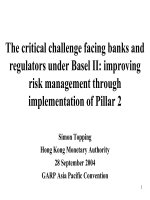The critical challenge facing banks and regulators under Basel II
Bạn đang xem bản rút gọn của tài liệu. Xem và tải ngay bản đầy đủ của tài liệu tại đây (146.53 KB, 16 trang )
1
The critical challenge facing banks and
regulators under Basel II: improving
risk management through
implementation of Pillar 2
Simon Topping
Hong Kong Monetary Authority
28 September 2004
GARP Asia Pacific Convention
2
Implementation of Basel II in Hong Kong
•
Hong Kong is one of the first jurisdictions to publish
detailed implementation plans for Basel II
•
Re Pillar 1, we will allow institutions to choose between
standardised approach, foundation IRB and advanced IRB
for credit risk, and between basic indicator approach and
standardised approach (not AMA) for operational risk; we
will also allow smaller institutions to choose a “basic”
approach
•
Institutions can now plan accordingly. The first big
question is whether - and when – to adopt IRB
•
But focus is now shifting to a second key consideration –
what plans to make in relation to “Pillar 2” risks
3
Main objectives of Pillar 2
•
Ensure that banks have adequate capital to support
all the material risks in their business
⇒
More comprehensive recognition of risk, including
risks not covered (e.g. interest rate risk in the banking
book) or not adequately covered (e.g. credit
concentration risk) under Pillar 1
•
Encourage banks to develop and use better risk
management techniques
⇒
Focus on banks’ capital planning and risk
management capabilities (not just on setting of
capital)
4
Four Pillar 2 Principles
•
Principle 1 : Banks should have a process for assessing their
overall capital adequacy in relation to their risk profile and a
strategy for maintaining their capital levels (i.e. CAAP)
•
Principle 2 : Supervisors should review and evaluate banks’
internal capital adequacy assessments and strategies
•
Principle 3 : Supervisors should expect banks to operate
above the minimum regulatory capital ratios and should have
the ability to require so
•
Principle 4 : Supervisors should seek to intervene at early
stage to prevent capital from falling below the minimum levels
required to support the risk characteristics of a particular bank
5
Principle 1
•
Banks should have a process for assessing their overall
capital adequacy in relation to their risk profile and a
strategy for maintaining their capital levels
•
Banks must be able to demonstrate that chosen internal capital
targets are well founded and that these targets are consistent with
their overall risk profile and current operating environment. In
assessing capital adequacy, bank management needs to be
mindful of the particular stage of the business cycle in which the
bank is operating. Rigorous, forward-looking stress testing that
identifies possible events or changes in market conditions that
could adversely impact the bank should be performed. Bank
management clearly bears primary responsibility for ensuring
that the bank has adequate capital to support its risks
6
The five main features of a rigorous process
for assessing capital adequacy
•
Board and senior management oversight
•
Sound capital assessment
•
Comprehensive assessment of risks
•
Monitoring and reporting
•
Internal control review









